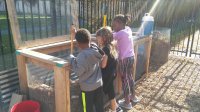Making the Most of Compost
Don’t throw that banana peel in the trash! Use a school compost bin to foster project-based learning across subjects and grade levels.
Your content has been saved!
Go to My Saved Content.For some time, only the most eco-centric teachers have attempted to use composting to teach science. But composting can be a rich source of project-based learning, with topics and activities to engage students at all levels.
For more than a decade, my Chicago elementary school has kept an active compost bin behind the building. A few teachers avoid it for the same reasons that so many people do: Compost is too messy, too smelly, too much work.
But most of my colleagues have embraced composting and used it as a foundation of student-led units that require creative problem-solving. The messiness and complexity of composting hooks students.
Using Compost as a Springboard for Learning
For many teachers and students, compost provokes essential questions that can lead to deep investigations.
How do things decompose? We use this question to leap into an exploration of the decomposers that live in a well-established compost pile: centipedes, millipedes, pillbugs and sowbugs, mites, and worms. There’s a food web unfolding right inside the compost pile, built around our waste. The bigger creatures are delightfully easy to find: Students eagerly dig up, count, place in terraria, and observe as many as they can find. Hand lenses help discover smaller mites, springtails, and more.
There are lots of ways to engage with this creepy-crawly world. In my elementary classes, groups try to classify each bug as vegetarian or predator. Right now, my second graders are having a big debate about whether worms need human protection from centipedes.
What kind of animal are worms? One preschool classroom at my school uses a worm bin—essentially a small, modular compost pile—to bring worms indoors for detailed study. These bins can be purchased online, but our students build one by punching or drilling air holes in a lidded plastic storage box.
The box is filled with alternating layers of damp newspaper, kitchen scraps, and soil—all collected by students—and then populated with worms. These are either earthworms caught outside or red wigglers, Eisenia fetida, available online for less than $20 on eBay or from a specialty retailer like Uncle Jim’s Worm Farm. Students watch to figure out what worms eat, identify their body parts, and observe them mating and laying eggs.
Why does a compost pile sometimes stink? A bad odor often results from a mismanaged (or simply neglected) compost pile—and offers a terrific opportunity for student inquiry. One year, the outdoor compost bin emanated an unusually sour smell and was encircled by wasps. So we arranged a middle-school design challenge to come up with a fix. Students interviewed compost experts from the community in small groups and compared notes. The consensus: Our compost bin contained too much fruit and too few “browns,” like leaves and wood chips, which support decomposers and greatly reduce odors. The students came up with a fix, too. Shredded paper from the school office and paper towels from bathrooms now go into the compost bin, as do leaves gathered by students.
If composting is so good for the environment, why don’t more people do it? Composting has clear environmental benefits. As much as 50 percent of waste in landfills could be composted instead. And the dark brown, sweet-scented, hummus-like finished compost is a soil amendment par excellence that replaces synthetic fertilizers and makes organic farming possible.
Once students learn these benefits—and become familiar with composting basics—they are well positioned for projects exploring social dynamics around waste. In a half-day workshop, our middle school students worked to help families move past their resistance to composting. Students identified common barriers, such as uncertainty about what to compost and unfamiliarity with how easy it is. Then they created marketing materials for the school compost program and even developed an incentive: a free, student-grown tomato plant for every family who used the school’s bin.
The Benefits of Composting at School
If you have a compost system in place at your school, it can provide demonstration points for what can feel like a slow process. Producing compost from end to end—apple core to crumbly hummus—can easily take six months in Chicago’s weather. With a system that receives waste every school day, there are always batches at different stages of decomposition—a time-lapse of matter changing from one form to another.
Moreover, creating a schoolwide compost system can in itself be an inspiring student-led project—although it does require more adult support than the units described above.
Composting aligns nicely with Next Generation Science Standards curricula on ecosystems, matter, and energy. But its application needn’t be limited to science: It can also drive math or literacy projects. Students of all ages can communicate the benefits of composting by documenting progress and explaining hows and whys through text, numbers, and images. For instance, every fall I have students create and distribute flyers in the blocks around school so that residents know that the school can take their compost. Each student makes a unique flyer that must capture why compost is important. The chance to reach out to an authentic audience—their own community—always excites them.
